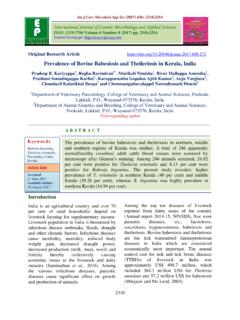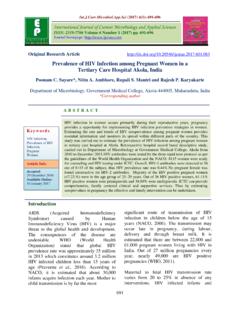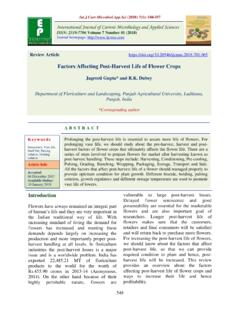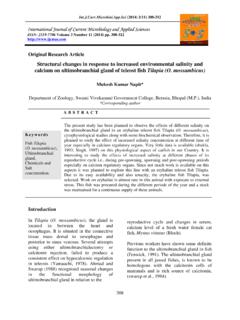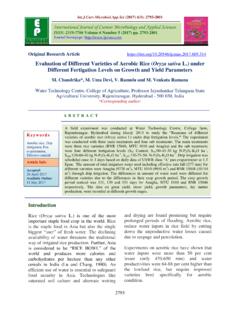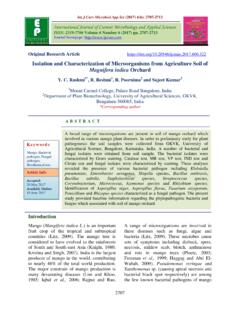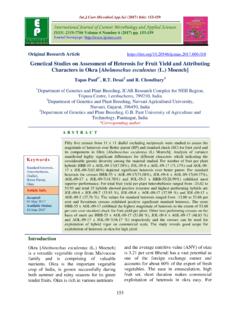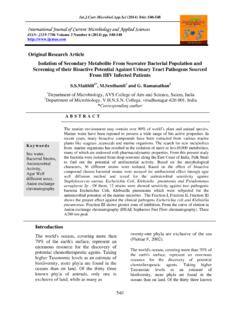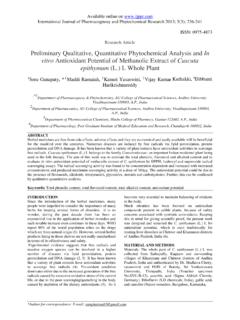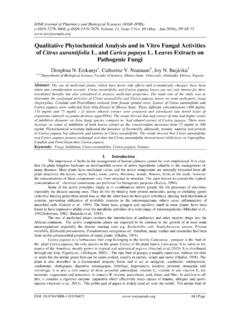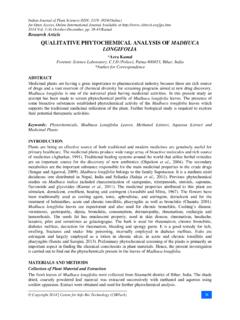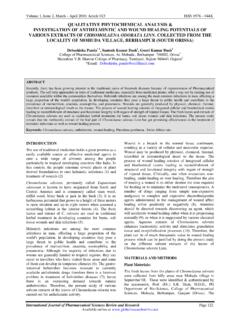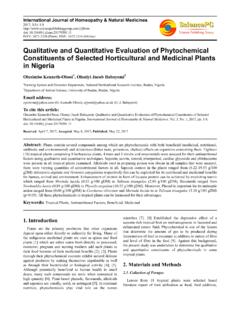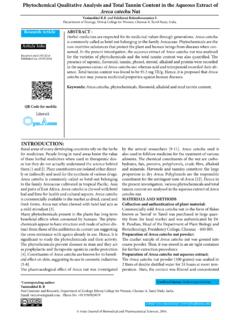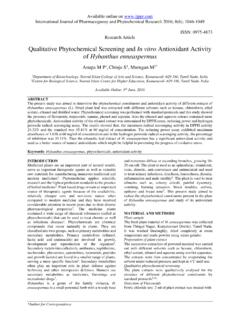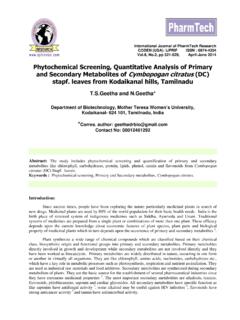Transcription of Qualitative and Quantitative Phytochemical Analysis of ...
1 (2018) 7(5): 657-665 657 Original Research Article Qualitative and Quantitative Phytochemical Analysis of Moringa oleifera (Lam) Pods Elzein M. Fahal, Babitha Rani, Aklakur, Chanu and Neelam Saharan* ICAR- Central Institute of Fisheries Education, Mumbai, India *Corresponding author A B S T R A C T Introduction Plants are unique source of food, medicinal artifacts, energy and shelter for both human and animal., many useful harvests obtained from plants directly or indirectly validate their importance to the human and other living organisms (Kawo, 2007). Moringa oleifera (Lam.) has many common names such as ben oil, drumstick, horseradish, and miracle tree. M. oleifera is a widely distributed species of the family Moringaceae.
2 It is a small graceful, deciduous plant with thin foliage and can grow up to 8 m height (Keay, 1989). Moringa is native to Western and sub Himalayan regions, India, Pakistan, Asia and Africa and it is distributed throughout the world in arid and semi-arid climate (Makkar and Becker, 1997). Moringa trees are having a remarkable range of medicinal properties as high as nutritional values. Most parts of the plant., leaves, seeds, fruit or pods, roots, stem, and bark are used as medicines or foods in various countries with especial references to the traditional communities. The leaves are rich source of both macro- and micronutrients, such as protein and many vitamins (Siddhuraju and Becker, 2003). Fresh leaf juice inhibits the growth of human pathogens (Das et al., 1957).
3 The seeds also show antimicrobial activity (Oliveira et al., 1999). Fruits or pods have wide spectrum of antimicrobial and antifungal activities against common pathogens (Sayeed et al., 2012). The roots have been reported to have antispasmodic and antimicrobial activity and used for diarrhea treatment (Caceres et al., International Journal of Current Microbiology and Applied Sciences ISSN: 2319-7706 Volume 7 Number 05 (2018) Journal homepage: Moringa oleifera (Lam.) has remarkable medicinal properties and nutritional value possessed by various parts of the tree Viz. leaves, seeds, pods, roots and bark. The therapeutic effects of M. oleifera are due to the combined actions or effects of various bioactive components or Phytochemical constituents such as alkaloids, flavonoids, saponins, sterols and tannins.)
4 The present study was carried out to find the availability of these five important phyto-constituents in aqueous, ethanol, methanol and chloroform extracts. Quantitative Analysis was also carried out for the same metabolites in Moringa pods crude extract. K e y w o r d s Phytochemicals, Moringa oleifera, Qualitative , Quantitative , Extracts, pods Accepted: 07 April 2018 Available Online: 10 May 2018 Article Info (2018) 7(5): 657-665 658 1992). Moringa contains specific plant pigments., alpha-carotene and beta-carotene, lutein and Phytochemical constituents such as alkaloids, flavonoids, saponins, sterols, phenols and tannins. The therapeutic effects of M. oleifera could be due to the combined actions of various bioactive components found in the plant, including trace metal ions, vitamins, alkaloids, polyphenols and other elements (Coppin, 2008) and they collectively act on broad physiological processes including metabolism and immunity (Amaglo et al.
5 , 2010). Materials and Methods Study area The research work was carried out at Division of Aquaculture, ICAR- Central Institute of Fisheries Education, Mumbai, Maharashtra, India. Moringa pods were collected from different trees around the CIFE campus in Versova area suburb of western Mumbai city. Plant materials Fresh dry samples from Moringa pods were submitted to Blatter Herbarium of ST. Xavier s College in Mumbai, India. The samples were identified and authenticated as Moringa oleifera (lam). The samples matched with the herbarium specimen number NI. 4891of N. A. Irani. For the research work, fresh and dry pods were collected and seed were removed from dry pods. The pods were blended as fine powder using, normal electrical grinder and kept in air tight container for further Analysis .
6 Plant extraction Aqueous extract was prepared using method described by Awodele et al., (2012). 100 g of sample powder was macerated in 2 liters of distilled water (MILLPORE, Q-gard1) for 24 hours. The solution was decanted and filtered using Whatman filter paper (QUALIGEN- Germany). The filtrate was dried in oven (Hexatec, Model HIPL03A) at 400C for 4days. The dry extract again was reconstituted in distilled water and used for the Qualitative Analysis . Chloroform extract was prepared using method described by Sathishkumar and Baskar, (2014). 100 g of sample powder was added to 400 ml chloroform and was shacken in water bath for ten hours. The solution then filtered using Whatman filter paper No. 1. The filtrate was dried using Rotary evaporator (IKA, model RV10B) to get the filtrate which again was dissolved in same amount of the solvent and used for further Analysis .
7 Ethanol extract was prepared using method described by Olatunde and Dikwa, (2014). 80 g of the sample powder was added to 400 ml ethanol (98%) for 72hours. The solution was filtered using Whatman filter paper No. 1. The solvent was evaporated using rotary evaporator. The filterate was again dissolved in same amount of the solvent and was used for further Analysis . Methanol extract was prepared using method described by Pavithra, et al., (2009). 50 g of the sample powder was added into a round beaker containing 500 ml of Methanol and kept for 24 hours and the solution then filtered using Whatman filter paper No. 1. The filtrate was evaporated at room temperature to get the dry extract which was dissolved in same amount of methanol and stored for further Analysis .
8 Qualitative screening of bioactive components Each extract was tested for presence of alkaloids, flavonoids, saponines, sterols and tannins using different methods. The tests were performed in triplicates to ensure the accurate results. (2018) 7(5): 657-665 659 Detection of alkaloids The occurrence of alkaloids was tested using method reported by Sabri et al., (2012). 10 ml of the extract were evaporated to dryness. Two ml of 2% HCL acid were added to the dry residue. Few drops of Wagner s reagent were added to the solution. The presence of alkaloids was confirmed when reddish brown precipitate occurred. Detection of flavonoids The test was based on method described by Pamar et al., (2012). Few drops of NaOH were added to two ml of the extract and intense yellow color appeared.
9 Few drops of dilute HCL were added and the solution turned to colorless as indicator of presence of flavonoids. Detection of saponins Precipitation and foam test method was used as described by Devmurari, (2010). Few drops of (1%) lead acetate solution were added to one ml of the extracts. Intense white precipitate appeared due to presence of Saponins. Foam test also confirmed presence of saponins in the extract, in which 20 ml of distilled water were added to one ml of the extract in graduated cylinder. The solution was shacken for 5 to15 minutes and formation of stable foam indicated the presence of saponins. Detection of sterols The test was performed based on method described by Solihah et al., (2012). Two ml concentrated sulphuric acid were added to two ml of the extract.
10 Formation of red precipitate indicated presence of sterols. Detection of tannins The test method was described by Ugochuhwu et al., (2013). One ml of 3% of Ferric chloride was added to one ml of the extract. Brownish green color development indicated presence of tannins. Quantitative Analysis of the bioactive constitutes Different methods were used to determine the amount of the required constitutes in the pods based on gravimetric tests. Three replicates were used for each test to ensure the accuracy. Estimation of alkaloids Alkaloids were quantified by the method described by Agoreyo et al., (2012). Five grams sample was weighed into beaker and 200 ml of 10 % acetic acid in ethanol were added. The mixture was covered and allowed to stand for four hours.

